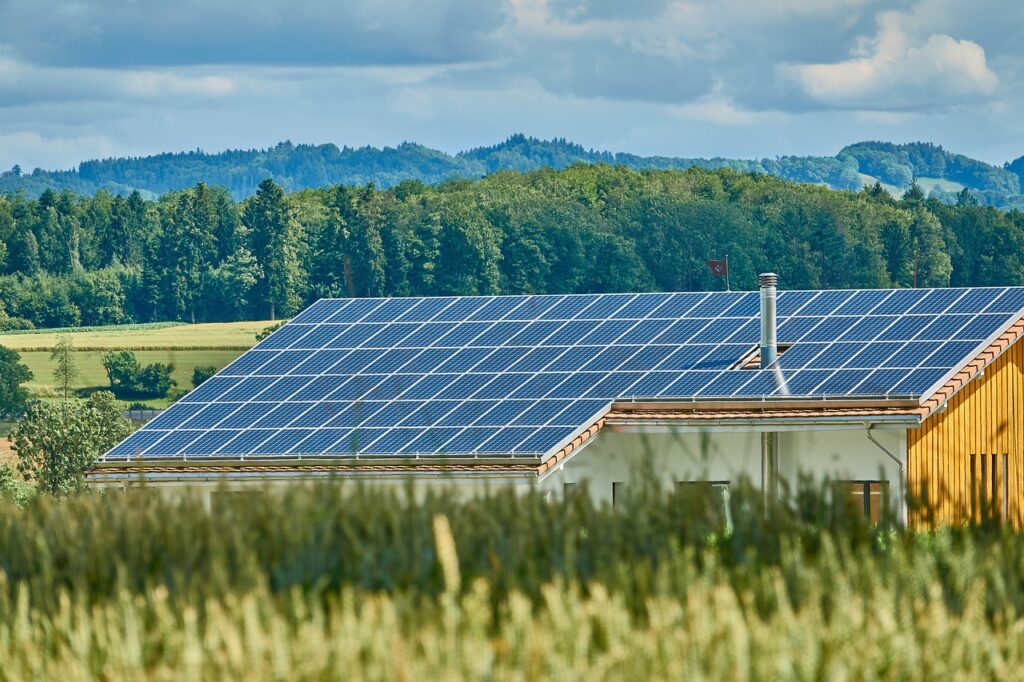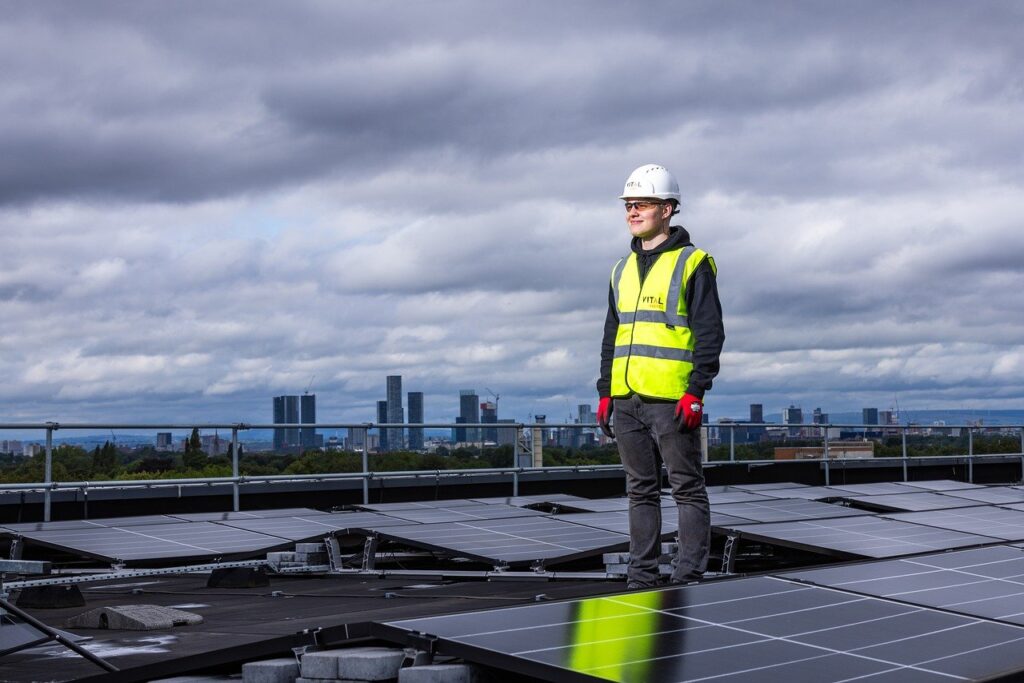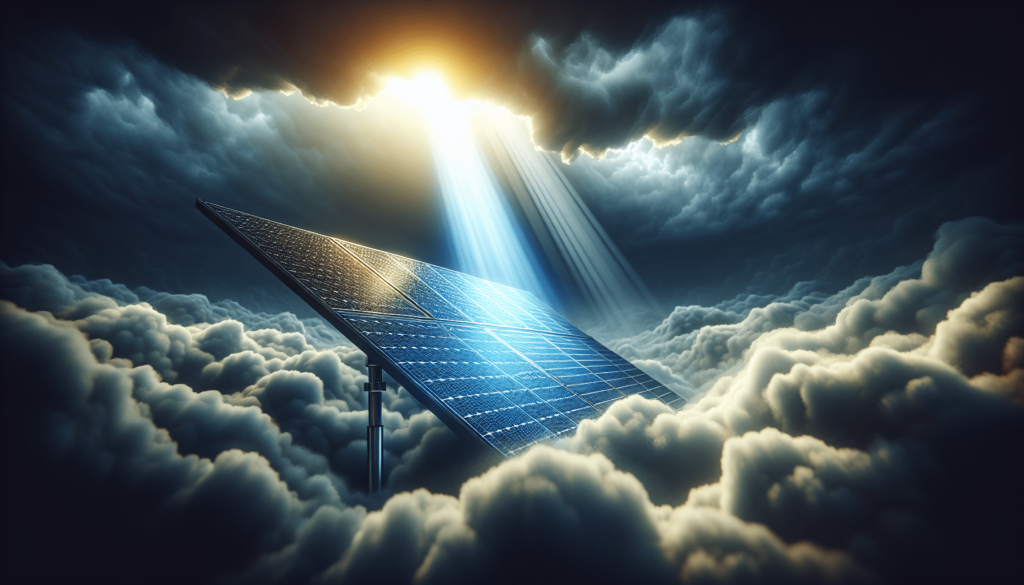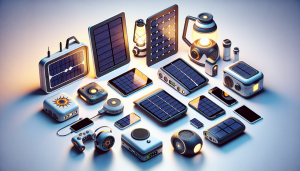Good news for all the eco-conscious individuals out there! We have all wondered whether solar panels can thrive even in cloudy weather conditions. Well, here’s the answer you’ve been waiting for. While it’s true that solar panels perform at their best under direct sunlight, there’s no need to worry about their efficiency during those cloudy days. In fact, solar panels are still remarkably effective in producing electricity, even when the sun is hiding behind the clouds. Allow us to demystify the science behind solar panel effectiveness in cloudy weather and shed light on this fascinating topic.

The Role of Sunlight in Solar Panels
Solar panels are an incredible source of renewable energy, and their effectiveness relies heavily on the abundant availability of sunlight. Sunlight serves as the primary source of energy that powers these green energy generators. Without sunlight, solar panels would not be able to harness the energy needed to convert it into usable electricity. Therefore, understanding the role of sunlight in solar panels is crucial in comprehending their overall effectiveness and performance.
Sunlight as the Source of Energy
Sunlight plays a vital role in the operation of solar panels as it acts as the primary source of energy. The photons present in sunlight are absorbed by the solar panels’ photovoltaic cells. These cells are responsible for converting sunlight into electricity through a process known as the photovoltaic process. The energy from sunlight is transformed into electrical energy, making it a clean and renewable alternative to traditional fossil fuels. Consequently, without a sufficient supply of sunlight, solar panels would not be able to generate electricity efficiently.
The Effectiveness of Solar Panels in Sunlight
Solar panels are highly effective when exposed to direct sunlight. The amount of sunlight received by the solar panels directly impacts their overall efficiency and performance. When in direct sunlight, solar panels can operate at their maximum efficiency, producing more electricity. This is due to the increased intensity of the sunlight, allowing the photovoltaic cells to absorb a greater number of photons, thus generating a higher amount of electricity. In direct sunlight conditions, solar panels can provide a consistent and substantial amount of electricity, making them an excellent choice for clean and renewable energy generation.
Types of Solar Panels
There are different types of solar panels available, each with its own unique characteristics and efficiency levels. These include polycrystalline solar panels, monocrystalline solar panels, and thin-film solar panels. Let’s explore each type to understand their differences and benefits.
Polycrystalline Solar Panels
Polycrystalline solar panels are made up of multiple crystals of silicon, resulting in a characteristic appearance with a bluish hue. These panels are cost-effective and offer good performance. They are highly efficient under direct sunlight, providing a reliable source of electricity. However, the presence of multiple crystals can reduce their efficiency in low light conditions, such as cloudy weather.
Monocrystalline Solar Panels
Monocrystalline solar panels are made from a single crystal structure, giving them a uniform black appearance. These panels have a higher efficiency rate as compared to polycrystalline panels. They perform exceptionally well in both direct sunlight and low light conditions, making them a more versatile option. Monocrystalline solar panels are ideal for regions with frequent cloudy weather, as they can still generate a significant amount of electricity even in less than optimal sunlight conditions.

Thin-Film Solar Panels
Thin-film solar panels are made from a thin layer of photovoltaic material deposited onto a backing material. These panels are flexible and lightweight, allowing for easy installation on various surfaces. While thin-film solar panels are more affordable and efficient in low light conditions compared to polycrystalline panels, they are less efficient in direct sunlight. Therefore, they are typically used in applications where limited sunlight is available, such as portable solar chargers or in situations where aesthetics and flexibility are important.
How Solar Panels Work
Understanding how solar panels work is essential to grasp their operations and efficiency. Solar panels utilize the photovoltaic process to harness sunlight and convert it into electricity that can be used to power homes, businesses, and appliances.
Photovoltaic Process
The photovoltaic process is the core mechanism by which solar panels convert sunlight into electricity. It involves the interaction between photons in sunlight and the semiconducting material within the solar panels.
The semiconducting material, usually silicon, absorbs the photons from sunlight, which excites the electrons present in the material. This creates an electric current that flows through the material, generating electricity. Metal conductive plates and wiring within the solar panels help collect this current and redirect it to power sources or energy storage systems.
Conversion of Sunlight into Electricity
Solar panels have a series of interconnected photovoltaic cells that work collectively to convert sunlight into electricity. These cells are made up of layers of silicon, each with different levels of electron acceptors and electron donors. When sunlight hits these layers, the photons excite the electrons and create an electric potential difference, leading to the flow of electricity.
The Role of Inverter
Once the solar panels convert sunlight into electricity, the generated direct current (DC) is then transformed into alternating current (AC) through the use of an inverter. AC electricity is the form of electricity used in homes and businesses. The inverter ensures that the electricity produced by the solar panels is compatible with the electrical grid or the appliances connected to the system.
The Impact of Cloudy Weather on Solar Panels
Cloudy weather can have a significant impact on the performance and efficiency of solar panels. The reduction in direct sunlight caused by clouds leads to decreased energy production and overall performance.

Reduction in Energy Production
During cloudy weather, the amount of sunlight reaching the solar panels is significantly reduced. This reduction in sunlight directly impacts the energy production of solar panels, resulting in a decrease in the amount of electricity generated. With less energy being produced, solar panels may not be able to meet the demand for electricity, especially during times of high energy consumption.
Effect on Efficiency and Performance
Cloudy weather also affects the efficiency and performance of solar panels. The decrease in sunlight intensity results in a lower generation of electricity, making solar panels less efficient. Additionally, the cooler temperatures associated with cloudy weather can improve the efficiency of solar panel performance to some extent, counteracting the negative effects of reduced sunlight. However, this improvement is not enough to compensate fully for the decrease in energy production.
Effects of Different levels of Cloud Coverage
Different levels of cloud coverage impact solar panel efficiency and energy production in varying degrees. Let’s explore the effects of partial cloud coverage, heavy cloud coverage, and overcast or dark clouds.
Partial Cloud Coverage
Partial cloud coverage refers to a situation where clouds partially obscure the sunlight, causing intermittent shading on the solar panels. This type of cloud coverage can have a moderate impact on solar panel efficiency. The intermittent shading prevents the solar panels from receiving consistent sunlight, resulting in fluctuations in energy production. However, solar panels equipped with bypass diodes can mitigate the effects of partial cloud coverage by bypassing shaded sections and maximizing energy production from unshaded areas.
Heavy Cloud Coverage
Heavy cloud coverage occurs when the sky is mostly covered with clouds, significantly reducing the amount of sunlight reaching the solar panels. In such conditions, solar panels may experience a significant decrease in energy production and efficiency. The opaque nature of heavy clouds obstructs a large portion of the sunlight, limiting the generation of electricity by the solar panels.
Overcast or Dark Clouds
Overcast or dark clouds can have the most detrimental impact on solar panel efficiency. These clouds block almost all sunlight, severely limiting the energy production of solar panels. Under overcast conditions, solar panels will generate significantly less electricity, which can be challenging to overcome without alternative energy sources or storage systems.

Improving Solar Panel Efficiency in Cloudy Weather
Despite the challenges posed by cloudy weather, there are ways to improve solar panel efficiency during such conditions. Implementing these strategies can help ensure a more consistent power supply and optimize the performance of solar panels.
Tilt and Angles of Solar Panels
Adjusting the tilt and angle of solar panels can maximize the absorption of sunlight during cloudy weather conditions. By angling the panels slightly more upright, they can capture as much available sunlight as possible. Proper alignment with the sun’s position throughout the day can optimize energy production, even in cloudy weather.
Installation of Solar Trackers
Solar trackers are devices that automatically adjust the positioning of solar panels to track the movement of the sun. By continuously following the sun’s path, solar panels can receive maximum sunlight exposure, even in cloudy conditions. Solar trackers maximize energy production by ensuring the panels are aligned at the most optimal angle to the sun, increasing overall efficiency.
Using Reflective Surfaces
The use of reflective surfaces can enhance solar panel efficiency in cloudy weather. Placing reflective materials, such as aluminum or mirrors, near solar panels can redirect and concentrate sunlight onto the panels. This enables the solar panels to receive a higher intensity of sunlight, compensating for the decreased energy production caused by cloudy weather.
The Role of Battery Storage Systems
Battery storage systems are integral to maintaining a constant power supply from solar panels, especially during periods of reduced sunlight. These systems store excess energy generated by solar panels during periods of high sunlight intensity, allowing it to be used when sunlight is limited or unavailable.
Storing Excess Energy
During sunny periods, solar panels often generate more electricity than is immediately required. A battery storage system allows for the excess energy to be stored and used later when sunlight is scarce. This ensures a consistent power supply, even in situations where solar panel energy production is limited.

Ensuring Constant Power Supply
Battery storage systems also play a crucial role in ensuring a constant power supply when solar panels are unable to generate enough electricity due to cloudy weather. By storing excess energy during optimal sunlight conditions, these systems provide a reliable backup source of power during periods of reduced sunlight. This reduces reliance on the electrical grid and promotes the usage of clean and renewable energy.
Government Policies and Incentives
Government policies and incentives play a vital role in encouraging the installation of solar panels and promoting the adoption of renewable energy sources.
Encouraging Solar Panel Installation
Many governments offer incentives and subsidies to individuals and businesses that install solar panels. These incentives can include tax credits, grants, and subsidies that make the upfront investment in solar panels more accessible and financially beneficial. By reducing the initial costs, government policies encourage more people to install solar panels, increasing the overall adoption of renewable energy.
Net Metering Programs
Net metering programs are another government policy that further promotes the usage of solar panels. Net metering allows the excess electricity generated by solar panels to be fed back into the electrical grid. In return, the electricity provider credits the owner with the value of the electricity supplied. This system incentivizes the installation of solar panels as it offers a way to offset electricity costs and potentially even generate revenue from excess energy generation.
Solar Power Purchase Agreements
Solar power purchase agreements (PPAs) involve an agreement between a solar panel system owner and a third party. The third party agrees to purchase the electricity generated by the solar panels at a predetermined price, typically lower than the utility’s rate. PPAs enable individuals or businesses to benefit from solar energy without the initial investment in the solar panel system. It allows for a greater adoption of solar panels and green energy, benefiting both the environment and the consumers.
Real-life Examples and Case Studies
Research and real-life examples provide valuable insights into the performance of solar panels in cloudy regions. Various studies have been conducted to assess solar panel efficiency and energy production in different climates, shedding light on their effectiveness in cloudy weather conditions.
Research and Findings
Research conducted by the National Renewable Energy Laboratory (NREL) has shown that solar panels can still generate a considerable amount of electricity, even in cloudy weather. The efficiency of solar panels in converting sunlight into electricity has been found to range from 10-25% on cloudy days, depending on the type of solar panel and the level of cloud coverage. This demonstrates that solar panels are still a viable and reliable source of electricity, even in regions with frequent cloudy weather.
Solar Panel Performance in Cloudy Regions
Real-world examples from regions with diverse weather patterns provide further evidence of solar panel performance in cloudy regions. For instance, Germany is known for its relatively cloudy climate, yet it has one of the highest solar panel installations in the world. This highlights the effectiveness of solar panels in producing electricity even under suboptimal sunlight conditions. Additionally, countries such as the Netherlands, the United Kingdom, and Canada have also seen significant growth in solar panel installations, despite their reputation for cloudy weather. These examples demonstrate that solar panels can still be an efficient and reliable source of energy, even in areas with less abundant sunlight.
Future Advancements in Solar Panel Technology
Advancements in solar panel technology are continually being made, with a focus on improving efficiency and performance. These advancements aim to enhance solar panels’ effectiveness in producing electricity, especially in challenging weather conditions such as cloudy weather.
Efficiency Improvements
Researchers and scientists are constantly striving to improve the efficiency of solar panels. New materials with enhanced light-absorption properties and increased energy conversion rates are being developed. These advancements would enable solar panels to generate more electricity from the same amount of sunlight, making them even more effective in producing clean and renewable energy.
Incorporation of Nanotechnology
Nanotechnology is being increasingly explored to improve solar panel efficiency. Scientists are developing nanomaterials that can optimize light absorption and improve the conversion of sunlight into electricity. By integrating nanotechnology into solar panel design, the energy production capabilities of solar panels can be further enhanced, making them more effective in capturing sunlight, even in cloudy weather.
Solar Panel Innovations
Innovations in solar panel design and construction are also contributing to their effectiveness in various weather conditions. Flexible solar panels, for example, allow for easy installation on curved surfaces, making them adaptable to different environments. Building-integrated solar panels and solar-powered windows are also being developed, further expanding the usage and applications of solar energy.
In conclusion, sunlight plays a crucial role in the effectiveness and performance of solar panels. It serves as the primary source of energy that powers these renewable energy generators. Different types of solar panels offer varying levels of efficiency and performance, with monocrystalline panels being especially effective in cloudy weather. Cloudy weather can have a significant impact on solar panel energy production and efficiency, but strategies such as adjusting panel angles and utilizing reflective surfaces can improve their performance. Battery storage systems also ensure a constant power supply, while government policies and incentives encourage solar panel installation. Research and real-life examples demonstrate the viability of solar panels in cloudy regions, and advancements in solar panel technology offer the promise of even greater efficiency in the future. With these advancements and strategies, solar panels can continue to play a vital role in the transition to clean and sustainable energy.




